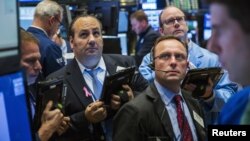When the Federal Reserve issues a statement Wednesday after its latest policy meeting ends, its words will likely be more important for what they say about the future than the present.
The reason: The Fed is all but certain to refrain from any increase in interest rates from the record lows where they have stood since 2008. But investors will scrutinize its statement for any clues to whether the Fed is leaning toward a rate hike at its last meeting of the year in December.
The statement is the only evidence Fed-watchers will have to review Wednesday because this meeting doesn't include a news conference by Chair Janet Yellen or an update of the central bank's economic forecasts.
Yellen and some other Fed officials have said a rate hike is still likely by the end of this year. But many analysts point to a string of weaker-than-expected economic reports in recent weeks that they think will lead the Fed to delay any rate increase until 2016.
What's changed is a global economic slowdown, led by China, that's inflicted wide-ranging consequences. U.S. job growth has flagged. Wages and inflation are subpar. Consumer spending is sluggish. Investors are nervous. And manufacturing is being hurt by a stronger dollar, which has made U.S. goods pricier overseas.
Though analysts say a rate hike at the central bank's next meeting in December is possible, two key Fed officials have called even that prospect into question.
The Fed cut its benchmark rate to near zero during the Great Recession to encourage borrowing and spending to boost a weak economy. Since then, hiring has significantly strengthened, and unemployment has fallen to a seven-year low of 5.1 percent.
But the Fed is still missing its target of achieving annual price increases of 2 percent, a level it views as optimal for a healthy economy.
At the start of the year, a rate hike was expected by June. A harsh winter, though, slowed growth. And then in August, China announced a surprise devaluation of its currency. Its action rocked markets and escalated fears that the world's second-largest economy was weaker than thought and could derail growth in the United States.
Uncertainty was too high, Fed officials decided, for a rate hike in September.
Since then, the outlook has dimmed further with a hiring slowdown and tepid retail sales and factory output. Also, inflation has fallen further from the 2 percent target because of falling energy prices and a stronger dollar, which lowers the cost of imports.
The Fed has said it will start raising rates once it's "reasonably confident" inflation will return to 2 percent within two to three years. Yellen has said that confidence should be boosted by a stronger job market, which will help raise workers' pay.
But this month, two Fed board members — Lael Brainard and Daniel Tarullo — questioned the link between falling unemployment and higher inflation. Both expressed doubts about whether the timing would be right for a rate hike this year.
This week's Fed meeting also follows decisions by other major central banks — from Europe to China and Japan — to pursue their own low-rate policies. Against that backdrop, a Fed rate hike would boost the dollar's value and thereby squeeze U.S. exporters of farm products and factory goods by making them costlier overseas.
Congress may help, if a budget deal announced Tuesday wins congressional approval. That could avert a threatened government shutdown and raise the government's borrowing limit — two threats that concern Fed policymakers.
Even if the Fed makes no policy changes Wednesday, there's still likely to be spirited debate at the meeting as Yellen seeks consensus on the timing of a rate hike — a debate not without risks.
"The on-and-off debate about when to raise interest rates has been adding to market uncertainties," said Sung Won Sohn, an economics professor at California State University, Channel Islands.










